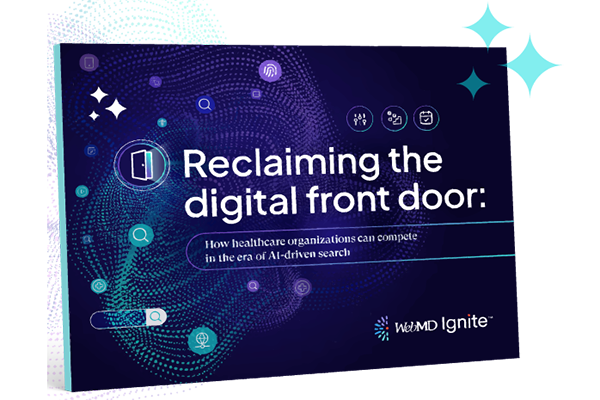Proactive Healthcare: Moving Away from Reactive Care Models
Editor's Note: This blog was published prior to the transition to WebMD Ignite.
For decades, both the healthcare industry and U.S. government have focused on managing healthcare costs, quality, and access. In the areas of quality and access, healthcare has moved the needle forward with advancements like EMRs, CRMs, the Affordable Care Act, and telehealth. Reducing healthcare costs, as well as providing solutions for all problems in the “cost, quality, and access” continuum, however, are hurdles that will only get more difficult to overcome.
In order to combat the growing cost of services, healthcare providers need to take an active role in promoting proactive healthcare. With targeted communication and improved patient engagement, physicians can put patients back in the driver’s seat and help them take control of health outcomes.
Let’s review differences between reactive and proactive care, as well as strategies for improving your proactive healthcare strategy:
Reactive vs. proactive healthcare
While the creation of HMOs, PPOs, the implementation of EHRs, and the ACA have contributed to improved population health to varying degrees, these “solutions” focus on a single encounter. You may have the flu today and be able to walk into an urgent care center for treatment, but one visit does not help you stay healthy.
We label this scenario “reactive health.”
What is reactive healthcare?
According to some estimates, reactive health accounts for more than 75% of healthcare spending in the U.S. A main contributor is chronic disease like heart disease or diabetes, which account for the majority of reactive health spending.
These chronic diseases are also responsible for 7 of every 10 deaths in the United States. However, many chronic diseases are either largely preventable or fairly easily managed if patients prioritize preventive care and work closely with their providers.
Approaching chronic conditions reactively does patients a disservice on two main fronts: first, reactive care does not work to stop them from getting sick or experiencing unpleasant symptoms in the first place. Second, reactive care is typically more expensive than what preventive care would have cost.
Historically, both health systems and patients viewed reactive care as the only option, mostly because of perceived financial barriers like copayments and deductibles. Additionally, fee-for-service payments models caused healthcare organizations to prioritize the sheer volume of patients served, reducing their focus on holistic patient care.
What is proactive healthcare?
The antithesis of “reactive health” is “proactive health.” Many consumers think, and many caregivers stress, that proactive health happens when a consumer takes responsibility to proactively manage his own health – moving away from the physician “treating an ailment or disease” to a patient practicing “self-care” activities such as exercising, taking prescribed medications and vitamins, drinking water, watching their weight, eating healthy, scheduling annual exams, and so on.
Benefits of adopting a proactive care model
Proactive healthcare initiatives strive to involve patients in their own care, allowing physicians and patients to work together to address health problems before they advance. This helps patients improve their health through lifestyle changes, rather than drastic intervention. Additionally, it helps health systems and consumers alike avoid the expense associated with high-risk conditions, such as spending multiple days in the ICU or needing emergency surgery.
This approach to managing high-risk conditions will also help health systems move toward value-based care. Value-based programs aim to improve quality of care while reducing healthcare costs over time, often by increasing healthcare literacy to minimize repeat visits or prevent expensive procedures.
Since proactive care values regular communication between health systems and patients, it also has a tangible effect on the patient experience. Through highly targeted outreach, you can send messaging to specific, well-defined groups of patients. For example, you could segment oncology patients who completed treatment more than two years ago and are overdue for a screening, then remind them to schedule their biannual screening. This thoughtful approach to patient outreach will show patients that you understand their needs, reinforcing their loyalty.
Tips to advance your proactive healthcare initiative
For a proactive healthcare model to work, a consumer must be compliant and commit to self-care. However, what few consumers realize is that the provider also has a responsibility to proactively manage the patient’s health – prevent disease, detect disease early, and improve healthcare results.
We define proactive health as:
“A commitment between a provider and a patient, where both parties take an active role in managing the patient’s health to keep the patient healthy.”
Here are some of the ways to help patients proactively manage their health:
Assess future risk with predictive modeling
Though physicians can urge their patients to practice self-care, the fact of the matter is - people will still develop chronic health conditions.
This is where predictive models can come into play. These models help identify patients who may be at risk for certain conditions in the future, and offer preventative practices that can delay or even reduce the likelihood of symptoms.
Predictive analytics is the process of deriving insights from patterns, correlations and data, and then using that information to drive more strategic marketing campaigns. In order to gather this insight, health systems need a data hub and healthcare analytics platform in place that aggregates clinical, financial, and consumer data for each patient.
With access to rich patient data, healthcare marketers can create predictive models to identify optimal campaign targets with statistical precision. In one specific use case, healthcare marketers used predictive modeling with health, demographic, and lifestyle variables to identify patients who were likely to need hip replacement surgery in the future.
The goal of predictive modeling is to refine a list of target prospects to ensure highly relevant communication reaches the right audience.
Engage patients with targeted communication
Once highly relevant patients are identified through predictive modeling, marketers can then reach out to them with targeted communication. In the case of proactive health initiatives, patients of similar ages, demographics, and lifestyles will likely receive these campaigns. The messaging marketers use should be highly personalized for each audience.
Ideally, this communication helps guide patients to make an appointment to see if they are at risk for a certain condition or need a procedure, or even share best practices for reducing risks or preparing for a procedure.
Engagement centers support marketers’ communication initiatives. When engagement center agents have access to a complete patient profile, they can improve the quality of interaction with each patient. A more personal and personalized form of communication than traditional marketing outreach (such as email), a phone conversation helps improve chances of success, whether that’s scheduling an appointment or requesting more information about a condition.
Final thoughts
A proactive health initiative can help healthcare drive down costs across the board, but also those associated with chronic illnesses. With the right communication, health systems can reduce the likelihood of certain conditions or improve the quality of life for patients who already have these conditions.
On top of improving patient satisfaction and engagement, personalized communication can spur patients’ willingness to take care into their own hands and improve outcomes. Overall, proactive health and preventative care can help health practitioners achieve the triple aim: Improving the quality of patient experiences, improving the health of populations, and reducing the cost of care.
Keep in mind that there is another key benefit of proactive health—improved patient retention rates. Retention is vital for health system success; it typically costs 5 to 25 times more to attract a new customer than retain an existing one, and a small 5 percent increase in customer retention produces a 25 percent increase in profit.
Proactive healthcare increases retention rates and extends patient lifetime value by engaging patients throughout their lifetimes, transforming them from potential one-time customers to patients for life.





